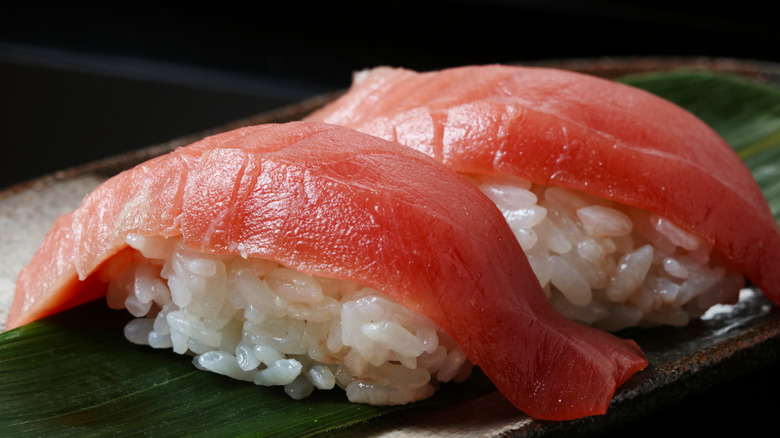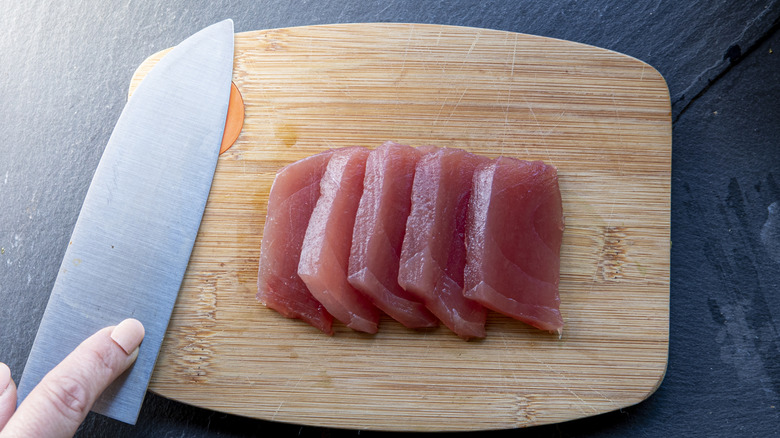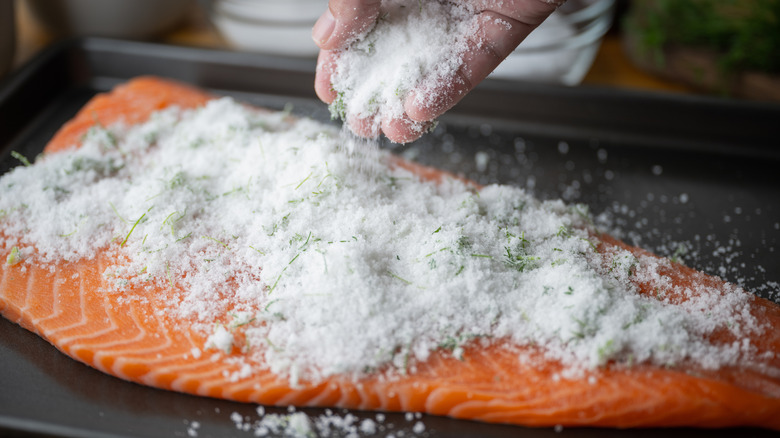For The Best Homemade Sushi, Dry-Cure Your Tuna First
Tired of turning a can of tuna into a sushi bake and want the real deal? Homemade sushi can go one of two ways; it can convince you that you never need to venture out to a restaurant again, or it can crush your hopes and dreams of being the next Hajime Sato, the first sushi chef to win a regional James Beard Award. If you're looking to upgrade your at-home sushi nights, there's one trick you have to know: dry-cure your tuna. It sounds simple enough, but this extra step will revolutionize your sushi game — all in thirty minutes!
Dry-curing goes back to antiquity as an affordable and easy method of food preservation. The primary component was (and still is) salt as it removes excess water, providing an environment where bad bacteria and microorganisms can't grow effectively. In sushi prep, dry curing makes the fish tender and easier to slice, without compromising its structural integrity. Thanks to all the seasoning, out goes the moisture, and in goes the flavor. Brief dry-curing won't give your fish an overly salty taste, but it will add a nice little twang to elevate the fish's natural flavor. Even better, according to a 2011 study for the International Journal of Food Science & Technology, dry-curing is effective at maintaining the natural Omega levels found in fish. All this for some salt and sugar!
How to dry-cure tuna
Dry-curing is simple. Take your sushi-grade tuna and coat it in equal parts salt and sugar (measure with your heart on this one). You can skip the sugar if you want and simply coat everything with salt. The sugar will give the fish a sweeter taste, but the salt does the bulk of the work anyway, so play around until you find what works for you.
Let that sit in an airtight container for around 30 minutes. During this time, the salt will absorb some of the excess moisture in the fish and bring out some delicious and complex flavors. After that, gently rinse your tuna with some cool water, and pat it dry. From here on out, the world is your oyster — or tuna? You can use the fish as-is for an elevated raw sushi experience (aka sashimi), or fry it up for a lightly cooked exterior. If you choose to cook your tuna on a grill or in a pan, the dry-curing will allow any skin you've left on to get extra crispy.
Other ways to cure fish for sushi
Salt and soy sauce are the go-tos for curing tuna, but there are actually a few other ways you can enhance your fish. Firstly, sugar is a great way to cure fish and change up the flavors. Traditional granulated white sugar works just fine, but you can also use honey or maple syrup. Sugar has the added benefit of providing food for the healthy bacteria that remain on the fish after the bad bacteria are extracted. This makes a great environment for good bacteria to thrive — including Lactobacillus, the bacteria that produce lactic acid, famed for helping the body break down and process carbohydrates.
Next up, try good old-fashioned smoking. There are two ways to do this: cold smoking and hot smoking. While cold smoking sounds like an oxymoron, it's only 'cold' in comparison to hot smoking. Cold smoking sees the fish cured at around 70 to 90 degrees Fahrenheit – while hot smoking gets up to 170 degrees Fahrenheit. Using wood smoke, heat the fish until stripped of its moisture, preserving it as well as giving it that delicious barbecue taste. The only thing to note is that cold smoking won't actually cook the fish, so it needs to be eaten as quickly as possible.



